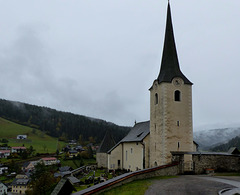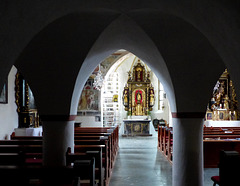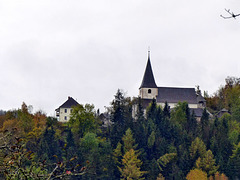
Carinthia / Kaernten
All photos were taken in Carinthia, the southernmost Austrian state.
Flattnitz - Hl. Johannes der Täufer
| |
|
|
The church in Flattnitz, dedicated to Saint John the Baptist, belongs to the parish of Glödnitz. It is located on the Flattnitz Pass, that may have been used already in Roman times.
Arnulf of Carinthia, an illegitimate son of Carloman, who became Carolingian king of East Francia after having overthrown his uncle Charles III (aka "Charles the Fat"), (and later even for two years Holy Roman Emperor), tranferred the ownership of Flattnitz to one supporters in 898. At that time silver and lead were extracted here.
Later it belonged to the Diocese of Gurk and Bischop Heinrich I had a round church erected here, that he consecrated in 1173. Within the next two centuries an "hospitium" was added and the church got altered and fortified. This did not keep the Turkish troops away, who sacked the area in 1478.
Unfortunately the church was locked.
Metnitz - St. Leonhard
| |
|
|
The fortified parish church of Metnitz, first mentioned in 1121, is best known for its Karner (ossuary) - and the Totentanz (= "Dance of Death", "Danse Macabre"), a fresco that runs all around the octagonal building.
The frescoes were done around 1500. In 1970 the original frescoes were removed from the wall and are now save in the local "Totentanzmuseum", next to the church.
Since 1989 here are copies of the originals.
Metnitz - St. Leonhard
| |
|
|
|
The fortified parish church of Metnitz, first mentioned in 1121, is best known for its Karner (ossuary) - and the Totentanz (= "Dance of Death", "Danse Macabre"), a fresco that runs all around the octagonal building.
The frescoes were done around 1500. In 1970 the original frescoes were removed from the wall and are now save in the local "Totentanzmuseum", next to the church.
Since 1989 here are copies of the originals.
Metnitz - St. Leonhard
| |
|
|
The fortified parish church of Metnitz, first mentioned in 1121, is best known for its Karner (ossuary) - and the Totentanz (= "Dance of Death", "Danse Macabre"), a fresco that runs all around the octagonal building.
The frescoes were done around 1500. In 1970 the original frescoes were removed from the wall and are now save in the local "Totentanzmuseum", next to the church. Since 1989 copies of the originals are seen around the Karner.
Metnitz - St. Leonhard
| |
|
|
The fortified parish church of Metnitz, first mentioned in 1121, is best known for its Karner (ossuary) - and the Totentanz (= "Dance of Death", "Danse Macabre"), a fresco that runs all around the octagonal building.
The frescoes were done around 1500. In 1970 the original frescoes were removed from the wall and are now save in the local "Totentanzmuseum", next to the church. Since 1989 copies of the originals are seen around the Karner.
Metnitz - St. Leonhard
| |
|
|
The fortified parish church of Metnitz, first mentioned in 1121. It is a Gothic church with Romanesque walls - and a Baroque interior.
Friesach - Burg Petersberg
| |
|
|
The ruin of "Burg Petersberg" located on a promontory towers over the central square of Friesach. The castle, built from 1076 on, was owned be the Bishops of Salzburg.
Richard I of England ( aka "Richard the Lionheart", "Richard Coeur de Lion") was in Friesach 1192 on flight after the Third Crusade. He was recognised but could escape. Some weeks later his way ended in the Leopold V´s dungeon.
Friesach - Hl. Bartholomäus
| |
|
|
The huge parish church in Friesach, dedicated to Saint Bartholomew, was
erected already in the 12th century. The higher eastern choir with the little turret was added 200 years later. Six times over the centuries the church got damaged by fires (last time 1895) - and each time it got rebuilt - and altered.
The massive "westwerk" has this look since a reconstruction that was completed in 1912.
Carinthia
Deutsch-Griffen - St. Jakobus
| |
|
|
Hemma of Gurk donated a chapel in "Grivinne" in 1043. The chapel belonged to the chapter of the Gurk cathedral in 1157 and around 1218 was the parish church Deutsch-Griffen.
The Romanesque structure was rebuilt as a fortified church in the 15th century, when it served as a refuge for the villagers during the Turkish incursions. Since then it is surounded by a strong wall. The Karner (ossuary) erected in the 14th century was used as a defense tower duirng that time.
Since 1755 church and churchyard are "connected" with the village in the vallye by a roofed stair with 178 steps.
Deutsch-Griffen - St. Jakobus
| |
|
|
|
Hemma of Gurk donated a chapel in "Grivinne" in 1043. The chapel belonged to the chapter of the Gurk cathedral in 1157 and around 1218 was the parish church Deutsch-Griffen.
The Romanesque structure was rebuilt as a fortified church in the 15th century, when it served as a refuge for the villagers during the Turkish incursions. Since then it is surounded by a strong wall. The Karner (ossuary) erected in the 14th century was used as a defense tower duirng that time.
Since 1755 church and churchyard are "connected" with the village in the vallye by a roofed stair with 178 steps.
Deutsch-Griffen - St. Jakobus
| |
|
|
Hemma of Gurk donated a chapel in "Grivinne" in 1043. The chapel belonged to the chapter of the Gurk cathedral in 1157 and around 1218 was the parish church Deutsch-Griffen.
The Romanesque structure was rebuilt as a fortified church in the 15th century, when it served as a refuge for the villagers during the Turkish incursions. Since then it is surounded by a wall. The Karner (ossuary) erected in the 14th century was used as a defense tower duirng that time.
Deutsch-Griffen - St. Jakobus
| |
|
Hemma of Gurk donated a chapel in "Grivinne" in 1043. The chapel belonged to the chapter of the Gurk cathedral in 1157 and around 1218 was the parish church Deutsch-Griffen.
The Romanesque structure was rebuilt as a fortified church in the 15th century, when it served as a refuge for the villagers during the Turkish incursions. Since then it is surounded by a wall. The Karner (ossuary) erected in the 14th century was used as a defense tower duirng that time.
Inside the church are some extraordinary frescoes, some in a bad state conditions. A conservationist was working inside and allowed us to enter.
Deutsch-Griffen - St. Jakobus
| |
|
|
|
Hemma of Gurk donated a chapel in "Grivinne" in 1043. The chapel belonged to the chapter of the Gurk cathedral in 1157 and around 1218 was the parish church Deutsch-Griffen.
The Romanesque structure was rebuilt as a fortified church in the 15th century, when it served as a refuge for the villagers during the Turkish incursions. Since then it is surounded by a wall. The Karner (ossuary) erected in the 14th century was used as a defense tower duirng that time.
Inside the church are some extraordinary frescoes, that were "re-discovered" under plaster in 1928. Most of them were created by a studio named "Villacher Schule", that existed from around 1440.
Some in a bad state conditions.
A conservationist was working inside the freezing cold church and allowed us to enter.
Deutsch-Griffen - St. Jakobus
| |
|
Hemma of Gurk donated a chapel in "Grivinne" in 1043. The chapel belonged to the chapter of the Gurk cathedral in 1157 and around 1218 was the parish church Deutsch-Griffen.
The Romanesque structure was rebuilt as a fortified church in the 15th century, when it served as a refuge for the villagers during the Turkish incursions. Since then it is surounded by a wall. The Karner (ossuary) erected in the 14th century was used as a defense tower duirng that time.
Inside the church are some extraordinary frescoes, that were "re-discovered" under plaster in 1928. Most of them were created by a studio named "Villacher Schule", that existed from around 1440.
Some in a bad state conditions. The conservationist is working with painstaking care inside the freezing cold church. A hard job! Thank you!!
Deutsch-Griffen - St. Jakobus
| |
|
Hemma of Gurk donated a chapel in "Grivinne" in 1043. The chapel belonged to the chapter of the Gurk cathedral in 1157 and around 1218 was the parish church Deutsch-Griffen.
The Romanesque structure was rebuilt as a fortified church in the 15th century, when it served as a refuge for the villagers during the Turkish incursions. Since then it is surounded by a wall. The octagonal Karner (ossuary) erected in the 14th century was used as a defense tower duirng that time.
The Karner is dedicated to Saint Oswald (of Northumbria). The basement is still full of human bones.
Tiffen - St. Jakobus
| |
|
A church, overlooking the valley, existed on the promontory since about 1050. The church seen here was erected, where once a Roman temple had been, within the 12 century, but later got strong Gothic and Baroque enlargements and alterations.
The church and the surrounding area got fortified in the 15th century, during the times of the Turkish and Magyar incursions. It is still surounded by walls and protected by a Karner (ossuary) that served as a defense tower.
Tiffen - St. Jakobus
| |
|
A church, overlooking the valley, existed on the promontory since about 1050. The church seen here was erected, where once a Roman temple had been, within the 12 century, but later got strong Gothic and Baroque enlargements and alterations.
The church and the surrounding area got fortified in the 15th century, during the times of the Turkish and Magyar incursions. It is still surounded by walls and protected by a Karner (ossuary) that served as a defense tower. It occupies the highest point of the protected territory, what is the graveyard today.
Jump to top
RSS feed- Latest items - Subscribe to the latest items added to this album
- ipernity © 2007-2024
- Help & Contact
|
Club news
|
About ipernity
|
History |
ipernity Club & Prices |
Guide of good conduct
Donate | Group guidelines | Privacy policy | Terms of use | Statutes | In memoria -
Facebook
Twitter


















